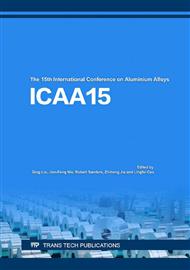p.104
p.109
p.114
p.121
p.127
p.132
p.141
p.147
p.153
Influence of Die Casting Temperature and T1 Treatment on the Microstructure and Properties of the Alsicumg Alloy
Abstract:
Al-Si alloy was widely applied in automobile engine parts to realize weight reduction. The influence of casting temperature on the microstructure of die casting Al-Si-Cu-Mg alloy was studied in this paper. Based on ZL 101 alloy, the strength was improved with addition of 0.8% Cu element. The influence of pouring temperature on microstructure was investigated using optical microscope and electron probe micro-analysis (EPMA), and T1 heat treatment was optimized. The primary α-Al was more coarsened when the pouring temperature rose from 660 ̊C to 690 ̊C. The solid solubility of Cu in α-Al was 0.2406 wt%, analyzed by EPMA. Considering the solid solubility of Cu and avoiding porosity at high-temperature, T1 heat treatment was reasonable and affective. The micro-hardness reached to a peak value of 114 HV during aging at a temperature of 175 ̊C after 10 h. Therefore, 175 ̊C×10h aging was the most appropriate heat treatment process.
Info:
Periodical:
Pages:
127-131
Citation:
Online since:
November 2016
Authors:
Keywords:
Price:
Сopyright:
© 2017 Trans Tech Publications Ltd. All Rights Reserved
Share:
Citation:


